VBOX Speed Sensors (25Hz v1/100Hz v1-4) - Quick Start Guide
- Last updated
-
-
Save as PDF
-
What is in the box?
| Product Code |
Quantity |
Description |
Product Code |
Quantity |
Description |
| VBSS25 |
1 |
VBOX Speed Sensor unit (25 Hz) |
VBSS100-V4G |
1 |
VBOX Speed Sensor unit (100 Hz) |
| RLVBACS018 |
1 |
GNSS antenna with
SMA connector (5 m) |
RLACS156 |
1 |
GPS/GLONASS antenna with
SMA connector (4 m) |
| Note: You may have to order additional cables separately |
You can find the full specification for your VBOX Speed Sensor here.
Registration
Please register your VBOX Speed Sensor so that Racelogic can continue to provide you with notifications about the latest software releases and firmware upgrades for your Racelogic product and offer technical support.
Register your device here.
Setup
Your VBOX Speed Sensor is ready to use out of the box, applying the default settings. However, you can change the setup by using the VBOX Setup Software to edit the settings written to the Speed Sensor.
To read more about how you can configure your Speed Sensor, see the VBOX Speed Sensor Configuration chapter.
Mounting
The VBOX Speed Sensor should be securely mounted inside the vehicle, level with the ground. There are holes in the ground plate that can be used to fasten the Speed Sensor to a suitable location in the vehicle. Make sure that the surface with the LEDs and pin information is up.
Hardware
Connect the serial plug to the computer's serial port with an RLCAB093 loom – you can also do this via a serial > USB converter if required.
Note: The RLCAB093 loom is not supplied with the VBOX Speed Sensor, but is available to purchase separately.
Power
The VBOX Speed Sensor can be powered from a wide range of voltage sources including a Vehicle Cigar adapter, a Racelogic Li-ion battery pack or other sources provided by the user. The maximum operating voltage input must not exceed 30 V DC. Failure to observe this limit could result in damage to the speed sensor.
Note: There is no power cable supplied with the VBOX Speed Sensor, but this is available to purchase separately.
Note: During extended use, the Speed Sensor's case may become hot. This is normal, however, it is good practice to mount the VBOX Speed Sensor in a position where it has sufficient airflow around the case.
GPS Coldstart
You may need to perform a GPS Coldstart when:
- The GPS/GNSS engine has locked up.
- The Speed Sensor is struggling to acquire satellite lock
A GPS coldstart forces the GPS engine to reset its downloaded almanac of current satellite positions. This can be useful if the Speed Sensor is having trouble locking onto satellites, which typically occurs if the unit has not been used for several weeks or if it was last used a long distance (over one thousand miles) away from the current location.
After performing a GPS coldstart, leave the Speed Sensor powered up in a static location where the antenna has an unobstructed view of the skies until the ‘GPS’ LED becomes solid green.
Find the instructions for performing coldstarts here.
Configuration
The VBOX Speed Sensors have default settings applied so that you can use them straight out of the box. You can, however, also configure the settings for your Speed Sensor, by using the VBOX Setup software, which you can download here. Find more information about how to configure your VBOX Speed Sensor here in the VBOX Speed Sensor User Guide.
VBOX Speed Sensor Digital Input
You can use the Digital Input on the VBOX Speed Sensor to program the position of virtual lines which lets you set Start/Finish and Split lines. Racelogic can provide different triggers and switches to use with this feature. For more information on available Digital input accessories, click here.
Read more about how you can configure your VBOX Speed Sensor to set the function of the Digital Input to either Lap pulse or Brake Trigger mode here.


